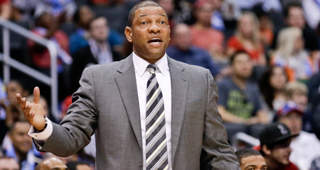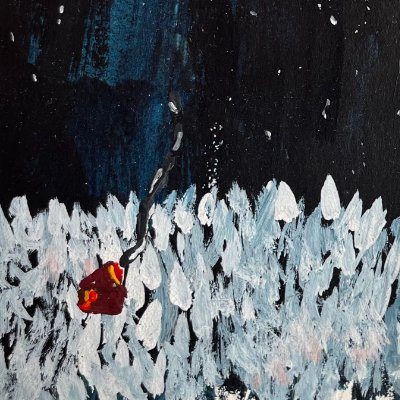The Clippers’ season effectively ended on Monday night, when Chris Paul broke his hand. Their first-round series against the Blazers is knotted at 2-2, but even if the Clips manage to make it past Dame Lillard and company, they don’t stand a chance against even a Steph Curry-less Warriors team without Paul and now without Blake Griffin. The Clips will busy themselves with granular schemery and matchups minutiae for the next little while, but they must know they’re staring down an offseason that’s going to involve some deep thinking on what to do next.
It’s hard to tell what a media creature like Doc Rivers actually thinks. When he’s gabbing to reporters, he frequently adopts the tone of a whiny self-delusionist, using any excuse at hand to avoid placing the burden of failure on his team or himself. The referees, injuries, and blind luck are always to blame for the Clippers' demise. But even given Doc’s public aversion to the truth, he can’t be so blind not to realize that we’re coming to the end of year five of the Blake Griffin and CP era in Los Angeles, and the Clips still haven’t advanced past the Western Conference Semifinals. Calls to blow up title contenders that underperform are always swift and only sometimes correct, but a half-decade is surely enough time for us to have arrived at a few conclusions about what the Clippers can achieve as currently constituted.
The squad’s central issue is that Griffin and Paul don’t fit together perfectly. Over the years, when one has been out for a spell, the other typically plays out of his mind and the team’s overall performance doesn’t suffer much, if at all. When Paul missed an 18-game chunk of midwinter action in 2014, Griffin demonstrated the expansiveness of his talents and played as a part-time point forward, averaging 27.5 points, 8.2 rebounds, and 4.4 assists per night over that span. He went on to finish third in the MVP voting, his case bolstered by the job he did in Paul’s absence. The following season, Griffin was out for 15 games in February and March. Paul’s Griffin-independent numbers: 20.5 points on 50.8 percent shooting and 12 assists per game. This year, the Clippers are 31-and-16 without Griffin.
It stands to reason that great players would rack up gaudier numbers when they have greater offensive responsibilities than usual, but the fact that Griffin and Paul are MVP candidates when they don’t share the floor and diminished when they’re together is indicative of an intractable problem. They just can’t make each other as spectacular as they seem like they should be when you watch them play by themselves. Griffin is about three additional feet of range on his jumper away from being a true floor-spacer, so he hems in the room Paul has to operate on drives and pick-and-rolls, and Paul being the best pure point of his generation means that Griffin’s estimable skills as a playmaker are underutilized. They help each other in the sense that opposing defenses have to concern themselves two lethal threats instead of one, but literally and figuratively, one occasionally gets in the other’s way.
DeAndre Jordan is well and truly the third banana in Los Angeles, and there’s a case to be made he’s more Chris Paul byproduct than any kind of star, but he does play extremely effectively off of Paul. He has a keen sense of timing when rolling off high screens and dunks everything that can possibly be dunked. Defensively, he’s not circa 2009 Dwight Howard, but he has the shot-blocking chops to make driving guards uncomfortable and the discipline not to hunt every swat available. The Clips would allow disastrous scoring totals without him, even if they occasionally do so with him, too.
Jordan’s flaws are obvious: the horrendous free throw shooting, the nonexistent jumper, the fact that he has no one to guard when opponents go small. But as far as the Clips are concerned, the biggest problem with Jordan is that he doesn’t pair well with Blake Griffin and his aforementioned 20-foot range. It’s difficult, in the modern NBA, to have two big men who play heavy minutes together and can’t shoot threes. It’s even worse when one of them doesn’t shoot at all. The Clippers find ways to make this work because Jordan is quite good and Griffin is some unholy mashup of Charles Barkley and Shawn Kemp, but it’s another case of the team being less than the sum of its parts.
One of these three core guys has to go this summer. Doc Rivers suggested as much in the preseason and shouldn’t let the knocks that have sunk the Clippers’ very slim title hopes dissuade him from exploring every trade possibility he can dream up. There’s a slight chance GM LeBron could entertain a Kyrie Irving for Chris Paul swap this summer, which is the only fair value CP deal that’s floating in the NBA rumor ether. Jordan is more valuable to the Clippers than to any other team in the league, so they probably couldn’t get a decent haul for him. The most likely candidate to leave town is Griffin, who seems to have alienated many in the organization by getting into brutal fight with the Clippers’ equipment manager a few months ago and who is just young and talented enough for a handful of general managers to forget that incident and make Rivers a tempting offer.
A shakeup, of course, doesn’t guarantee any kind of success for the Clippers. They’re not one obvious trade away from getting on the Spurs’ or Warriors’ level. What is obvious is they can’t keep plugging away with this troika of players who aren’t totally complementary to each other. The league’s upper echelon is too strong for the Clips not to be getting everything they can out of everybody on their roster, and a new configuration would at least give them some slim chance of a trajectory-altering revelation. Rivers might have to hold his nose for it, but he must make the rare justifiable change for change’s sake, because standing pat won’t get his team where they want to be.



